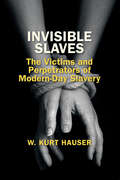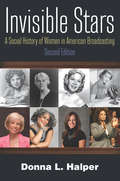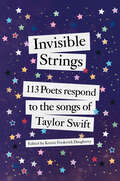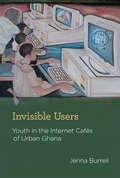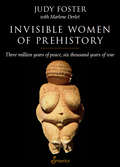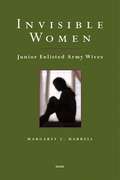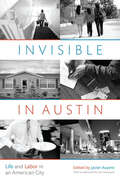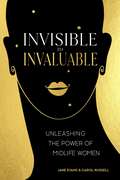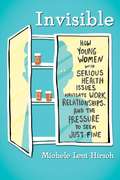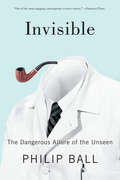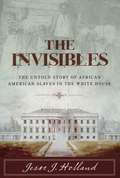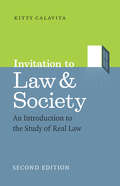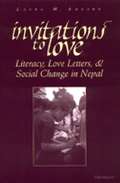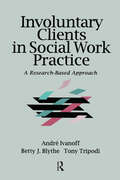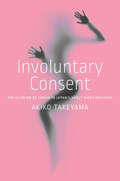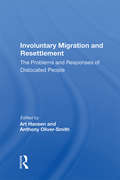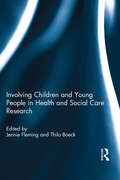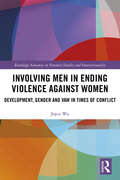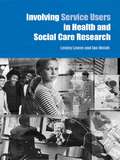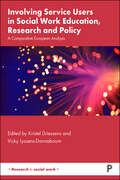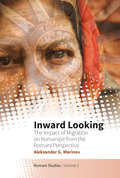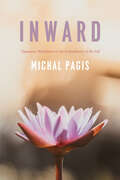- Table View
- List View
Invisible Slaves: The Victims and Perpetrators of Modern-Day Slavery
by W. Kurt HauserIn Invisible Slaves, W. Kurt Hauser discusses slavery around the world, with research and firsthand stories that reframe slavery as a modern-day crisis, not a historical phenomenon or third-world issue. Identifying four types of slavery—chattel slavery, debt bondage, forced labor, and sex slavery—he examines the efforts and failures of governments to address them. He explores the political, economic, geographic, and cultural factors that shape slavery today, illustrating the tragic human toll with individual stories. Country by country, the author illuminates the harsh realities of modern-day slavery. He explores slavery's effects on victims, including violence, isolation, humiliation, and the master-slave relationship, and discusses the methods traffickers use to lure the vulnerable, especially children, into slavery. He assesses nations based on their levels of slavery and efforts to combat the problem, citing the rankings of the United States' Trafficking Victims Protection Act. He concludes with an appeal to governments and ordinary citizens alike to meet this humanitarian crisis with awareness and action.
Invisible Stars: A Social History of Women in American Broadcasting
by Donna HalperInvisible Stars was the first book to recognize that women have always played an important part in American electronic media. The emphasis is on social history, as the author skillfully explains how the changing role of women in different eras influenced their participation in broadcasting. This is not just the story of radio stars or broadcast journalists, but a social history of women both on and off the air. Beginning in the early 1920s with the emergence of radio, the book chronicles the ambivalence toward women in broadcasting during the 1930s and 1940s, the gradual change in status of women in the 1950s and 1960s, the increased presence of women in broadcasting in the 1970s, and the successes of women in broadcasting in the 1980s and 1990s. The second edition is expanded to include the social and political changes that occurred in the 2000s, such as the growing number of women talk show hosts; changing attitudes about women in leadership roles in business; more about minority women in media; and women in sports and women sports announcers. The author addresses the question of whether women are in fact no longer invisible in electronic media. She provides an assessment of where progress for women (in society as well as broadcasting) can be seen, and where progress appears totally stalled.
Invisible Strings: 113 Poets Respond to the Songs of Taylor Swift
by Kristie Frederick DaughertyAn anthology of brand-new poems inspired by Taylor Swift songs, from a powerhouse group of contemporary poets, including Kate Baer, Maggie Smith, and Joy Harjo.Let the decoding begin! With a record-breaking four Grammy awards for Album of the Year, Taylor Swift stands alone in the world of pop music. One of the most talented lyricists of all time, her music captivates millions of fans throughout the globe with the narrative depth and emotional resonance of her songwriting.In Invisible Strings, poet, professor, and dedicated Swiftie Kristie Frederick Daugherty has brought together 113 contemporary poets, each contributing an original poem that responds to a specific Taylor Swift song.In a spirit of celebration and collaboration, poets have taken a cue from Swift&’s love of dropping clues and puzzles for her fandom to decode, as each poem alludes to a song without using direct lyrics. Swifties will enjoy closely reading each of the poems to discover which song each poet responded to; each poem responds to only one song.The collection showcases a diverse and accomplished array of writers including the 23rd US Poet Laureate Joy Harjo, Pulitzer Prize winners Diane Seuss, Yusef Komunyakaa, Carl Phillips, Rae Armantrout, Paul Muldoon, and Gregory Pardlo, National Book Critics Circle Award winners Mary Jo Bang and Laura Kasischke, and bestselling poets Maggie Smith, Aimee Nezhukumatathil, Kate Baer, amanda lovelace, Tyler Knott Gregson, and Jane Hirshfield.Swifties will experience the profundity and nuance of Swift&’s lyrics through these poems, while having fun matching the poems to songs from all of her eras—vault tracks included! For poetry lovers, this one-of-a-kind anthology is an unparalleled collection of new work from today&’s most lauded and revered poets.
Invisible Users: Youth in the Internet Cafés of Urban Ghana (Acting with Technology)
by Jenna BurrellAn account of how young people in Ghana's capital city adopt and adapt digital technology in the margins of the global economy.The urban youth frequenting the Internet cafés of Accra, Ghana, who are decidedly not members of their country's elite, use the Internet largely as a way to orchestrate encounters across distance and amass foreign ties—activities once limited to the wealthy, university-educated classes. The Internet, accessed on second-hand computers (castoffs from the United States and Europe), has become for these youths a means of enacting a more cosmopolitan self. In Invisible Users, Jenna Burrell offers a richly observed account of how these Internet enthusiasts have adopted, and adapted to their own priorities, a technological system that was not designed with them in mind.Burrell describes the material space of the urban Internet café and the virtual space of push and pull between young Ghanaians and the foreigners they encounter online; the region's famous 419 scam strategies and the rumors of “big gains” that fuel them; the influential role of churches and theories about how the supernatural operates through the network; and development rhetoric about digital technologies and the future viability of African Internet cafés in the region.Burrell, integrating concepts from science and technology studies and African studies with empirical findings from her own field work in Ghana, captures the interpretive flexibility of technology by users in the margins but also highlights how their invisibility puts limits on their full inclusion into a global network society.
Invisible Victims
by Laura HueyDespite Western society's preoccupation with safety and protection, its most vulnerable members still lack access to the level of security that many of us take for granted. In this trailblazing study, Laura Huey illustrates the issue of a 'security gap' faced by increasing homeless populations: while they are among the most likely victims of crime, they are also among the least served by existing forms of state and private security.Invisible Victims presents the first comprehensive, integrated study of the risks faced by homeless people and their attempts to find safety and security in often dangerous environments. Huey draws not only on current debates on security within criminology, but also on a decade's worth of her own field research on the victimization and policing of the homeless. A theoretically and empirically informed examination of the myriad issues affecting the homeless, Invisible Victims makes a compelling case for society to provide necessary services and, above all, a basic level of security for this population.
Invisible Women of Prehistory: Three Million Years of Peace, Six Thousand Years of War
by Marlene Derlet Judy FosterBased on many years of research into ancient history and prehistory, this insightful tome argues that three million years of peace--a period when women's status in society was much higher than it is now--preceded the last 6,000 years of war during which men have come to hold power over women. The book challenges the idea accepted in academia that history is a linear development in which society is steadily moving out of a violent and patriarchal past to a more equitable and peaceful future, and it reexamines both the archaeological work of Marjia Gimbutas and recent research into the prehistories of Africa, Asia, the Americas, and Australia and Oceania.
Invisible Women: Junior Enlisted Army Wives
by Margaret C. HarrellMilitary manpower policy is often crafted by policymakers without an in-depth understanding of the life experiences and views of junior enlisted personnel. It is plausible to expect that some policymakers attribute the attitudes and experiences of these young soldiers to such features as youth or lack of an advanced education and may thus believe themselves able to empathize with this population group by recalling their own parallel life experiences. However, this approach oversimplifies the life experiences of these families and neglects the reality that most policymakers and professional managers have never experienced the compendium of problems these couples face, such as youth, lack of education, financial difficulties, emotional and physical distance from extended family, and invisibility in a large bureaucracy. At the center of this book are the personal stories of three junior enlisted spouses, told in their own voices and selected to emphasize the dilemmas numerous enlisted families face. The stories provide insight into the experiences and attitudes of other junior enlisted families. Those interested or involved in the military, or those who live a military lifestyle--at any pay grade--will find these stories both useful and engaging.
Invisible in Austin: Life and Labor in An American City
by Javier AuyeroAustin, Texas, is renowned as a high-tech, fast-growing city for the young and creative, a cool place to live, and the scene of internationally famous events such as SXSW and Formula 1. But as in many American cities, poverty and penury are booming along with wealth and material abundance in contemporary Austin. Rich and poor residents lead increasingly separate lives as growing socioeconomic inequality underscores residential, class, racial, and ethnic segregation. <P><P> In Invisible in Austin, the award-winning sociologist Javier Auyero and a team of graduate students explore the lives of those working at the bottom of the social order: house cleaners, office-machine repairers, cab drivers, restaurant cooks and dishwashers, exotic dancers, musicians, and roofers, among others. Recounting their subjects’ life stories with empathy and sociological insight, the authors show us how these lives are driven by a complex mix of individual and social forces. These poignant stories compel us to see how poor people who provide indispensable services for all city residents struggle daily with substandard housing, inadequate public services and schools, and environmental risks. Timely and essential reading, Invisible in Austin makes visible the growing gap between rich and poor that is reconfiguring the cityscape of one of America’s most dynamic places, as low-wage workers are forced to the social and symbolic margins.
Invisible to Invaluable: Unleashing the Power of Midlife Women
by Jane Evans Carol RussellOur generation is something the world has never seen before. Women born between 1950 and 1975 were pioneers in all areas of work and society, yet we have become almost completely invisible except to our families and friends, right at the time the world needs our wisdom, empathy and experience the most.OUR TIME IS NOW!INVISIBLE TO INVALUABLE is a celebration of what midlife women do, who we are and what we are capable of. It's a rallying cry for us to change the world for the better.With personal stories, exciting research and insights from a cast of inspirational women, Jane Evans and Carol Russell's manifesto blows open the ageism that's sidelined midlife women at work and in society, and sets out an empowering vision for a world where we can unlock our full potential. In a collection of chapters that range from the powerful to the playful and from the distant past to a brighter future, Jane and Carol show how there is no longer just 'young' and 'old' - there is a whole new middle that can be the best time of our lives.Even if we feel like we've hit rock bottom, or have disappeared entirely, there is a way back. This book will remind you how far we've come, show you what we're made of, and demonstrate how we can create a better future for all of us.
Invisible to Invaluable: Unleashing the Power of Midlife Women
by Jane Evans Carol RussellOur generation is something the world has never seen before. Women born between 1950 and 1975 were pioneers in all areas of work and society, yet we have become almost completely invisible except to our families and friends, right at the time the world needs our wisdom, empathy and experience the most.OUR TIME IS NOW!INVISIBLE TO INVALUABLE is a celebration of what midlife women do, who we are and what we are capable of. It's a rallying cry for us to change the world for the better.With personal stories, exciting research and insights from a cast of inspirational women, Jane Evans and Carol Russell's manifesto blows open the ageism that's sidelined midlife women at work and in society, and sets out an empowering vision for a world where we can unlock our full potential. In a collection of chapters that range from the powerful to the playful and from the distant past to a brighter future, Jane and Carol show how there is no longer just 'young' and 'old' - there is a whole new middle that can be the best time of our lives.Even if we feel like we've hit rock bottom, or have disappeared entirely, there is a way back. This book will remind you how far we've come, show you what we're made of, and demonstrate how we can create a better future for all of us.
Invisible to Invaluable: Unleashing the Power of Midlife Women
by Jane Evans Carol RussellOur generation is something the world has never seen before. Women born between 1950 and 1975 were pioneers in all areas of work and society, yet we have become almost completely invisible except to our families and friends, right at the time the world needs our wisdom, empathy and experience the most.OUR TIME IS NOW!INVISIBLE TO INVALUABLE is a celebration of what midlife women do, who we are and what we are capable of. It's a rallying cry for us to change the world for the better.With personal stories, exciting research and insights from a cast of inspirational women, Jane Evans and Carol Russell's manifesto blows open the ageism that's sidelined midlife women at work and in society, and sets out an empowering vision for a world where we can unlock our full potential. In a collection of chapters that range from the powerful to the playful and from the distant past to a brighter future, Jane and Carol show how there is no longer just 'young' and 'old' - there is a whole new middle that can be the best time of our lives.Even if we feel like we've hit rock bottom, or have disappeared entirely, there is a way back. This book will remind you how far we've come, show you what we're made of, and demonstrate how we can create a better future for all of us.
Invisible: How Young Women with Serious Health Issues Navigate Work, Relationships, and the Pressure to Seem Just Fine
by Michele Lent HirschAn exploration of women navigating serious health issues at an age where they’re expected to be healthy, dating, having careers and children.Miriam’s doctor didn’t believe she had breast cancer. She did.Sophie navigates being the only black scientist in her lab while studying the very disease, HIV, that she hides from her coworkers.For Victoria, coming out as a transgender woman was less difficult than coming out as bipolar.Author Michele Lent Hirsch knew she couldn’t be the only woman who’s faced serious health issues at a young age, as well as the resulting effects on her career, her relationships, and her sense of self. What she found while researching Invisible was a surprisingly large and overlooked population with important stories to tell.Though young women with serious illness tend to be seen as outliers, young female patients are in fact the primary demographic for many illnesses. They are also one of the most ignored groups in our medical system—a system where young women, especially women of color and trans women, are invisible.And because of expectations about gender and age, young women with health issues must often deal with bias in their careers and personal lives. Not only do they feel pressured to seem perfect and youthful, they also find themselves amid labyrinthine obstacles in a culture that has one narrow idea of womanhood.Lent Hirsch weaves her own harrowing experiences together with stories from other women, perspectives from sociologists on structural inequality, and insights from neuroscientists on misogyny in health research. She shows how health issues and disabilities amplify what women in general already confront: warped beauty standards, workplace sexism, worries about romantic partners, and mistrust of their own bodies. By shining a light on this hidden demographic, Lent Hirsch explores the challenges that all women face.
Invisible: The Dangerous Allure of the Unseen
by Philip Ball“A very fun, largely chronological journey through invisibility, beginning with myth and early magicians, ending with quantum physics.” —The New YorkerIn this lively look at a timeless idea, Ball provides the first comprehensive history of our fascination with the unseen. This sweeping narrative moves from medieval spell books to the latest nanotechnology, from fairy tales to telecommunications, from camouflage to ghosts to the dawn of nuclear physics and the discovery of dark energy. Along the way, Invisible tells little-known stories about medieval priests who blamed their misdeeds on spirits; the Cock Lane ghost, which intrigued both Samuel Johnson and Charles Dickens; the attempts by Victorian scientist William Crookes to detect forces using tiny windmills; novelist Edward Bulwer-Lytton’s belief that he was unseen when in his dressing gown; and military efforts to enlist magicians to hide tanks and ships during WWII. Bringing in such voices as Plato and Shakespeare, Ball provides not only a scientific history but a cultural one—showing how our simultaneous desire for and suspicion of the invisible has fueled invention and the imagination for centuries.In this unusual and clever book, Ball shows that our fantasies about being unseen—and seeing the unseen—reveal surprising truths about who we are.“Full of insights drawn from a broad survey of history, literature and philosophy; wherever the invisible is being contemplated, Ball is there to select the juiciest anecdotes . . . [He] is a lucid, witty and highly entertaining guide.” —The Globe and Mail“A tour-de-force history capped off with an animated discussion of H.G. Wells’s novel The Invisible Man.” —Publishers Weekly (starred review)
Invisibles: Untold Story of African American Slaves in the White House
by Jesse HollandTHE INVISIBLES: Slavery Inside The White House and How It Helped Shape America is the first book to tell the story of the executive mansion's most unexpected residents, the African American slaves who lived with the U. S. presidents who owned them. Interest in African Americans and the White House are at an all-time high due to the historic presidency of Barack Obama, and the soon-to-be-opened Smithsonian National Museum of African American Culture and History. The Invisibles chronicles the African American presence inside the White House from its beginnings in 1782 until 1862, when President Abraham Lincoln issued the Emancipation Proclamation that granted slaves their freedom. During these years, slaves were the only African Americans to whom the most powerful men in the United States were exposed on a daily, and familiar, basis. By reading about these often-intimate relationships, readers will better understand some of the views that various presidents held about class and race in American society, and how these slaves contributed not only to the life and comforts of the presidents they served, but to America as a whole.
Invitation to Law and Society, Second Edition: An Introduction to the Study of Real Law (Chicago Series in Law and Society)
by Kitty CalavitaLaw and society is a rapidly growing field that turns the conventional view of law as mythical abstraction on its head. Kitty Calavita brilliantly brings to life the ways in which law is found not only in statutes and courtrooms but in our institutions and interactions, while inviting readers into conversations that introduce the field's dominant themes and most lively disagreements. Deftly interweaving scholarship with familiar examples, Calavita shows how scholars in the discipline are collectively engaged in a subversive exposé of law's public mythology. While surveying prominent issues and distinctive approaches to both law as it is written and actual legal practices, as well as the law's potential as a tool for social change, this volume provides a view of law that is more real but just as compelling as its mythic counterpart. With this second edition of Invitation to Law and Society, Calavita brings up to date what is arguably the leading introduction to this exciting, evolving field of inquiry and adds a new chapter on the growing law and cultural studies movement.
Invitations To Love: Literacy, Love Letters, And Social Change In Nepal
by Laura M. AhearnInvitations to Love provides a close examination of the dramatic shift away from arranged marriage and capture marriage toward elopement in the village of Junigau, Nepal. Laura M. Ahearn shows that young Nepalese people are applying their newly acquired literacy skills to love-letter writing, fostering a transition that involves not only a shift in marriage rituals, but also a change in how villagers conceive of their own ability to act and attribute responsibility for events. These developments have potential ramifications that extend far beyond the realm of marriage and well past the Himalayas. The love-letter correspondences examined by Ahearn also provide a deeper understanding of the social effects of literacy. While the acquisition of literary skills may open up new opportunities for some individuals, such skills can also impose new constraints, expectations, and disappointments. The increase in female literacy rates in Junigau in the 1990s made possible the emergence of new courtship practices and facilitated self-initiated marriages, but it also reinforced certain gender ideologies and undercut some avenues to social power, especially for women. Scholars, and students in such fields as anthropology, women's studies, linguistics, development studies, and South Asian studies will find this book ethnographically rich and theoretically insightful. Laura M. Ahearn is Assistant Professor of Anthropology, Rutgers University.
Involuntary Clients in Social Work Practice: A Research-Based Approach (Modern Applications of Social Work Series)
by Tony Tripodi Andre Ivanoff Betty J. BlytheFirst published in 1994. While not setting out to write a book about social policy, Ivanoff, Blythe and Tripodi, seasoned and well-known contributors to the spirited debate on the proper relationship of research and practice methods in direct services, have, nonetheless, delivered much useful commentary on how those direct services resources ought best be deployed. This book is to a clear call for commitment of skilled professional resources for those citizens whose serious and often multiple problems have already deeply involved them in public sector services.
Involuntary Consent: The Illusion of Choice in Japan’s Adult Video Industry
by Akiko TakeyamaThe popularity of pornography is predicated on the idea that those participating have given their consent. That is what allows the porn industry to dominate the media economy today, generating staggering sums of money. Looking at behind-the-scenes negotiations and abuses in Japan's adult video industry, author Akiko Takeyama challenges this pervasive notion with the idea of "involuntary consent." This phenomenon, she argues, is ubiquitous, not only in the porn industry, but in our everyday lives. And yet modern society, built on beliefs of autonomy, free choice, and equality, renders it all but invisible. Japan's AV industry alone generates a conservatively estimated $5 billion a year. In recent years, it has drawn public attention, and criticism, because of a series of arrests and trials of former talent agency owners and executives. This led to a report calling for a systematic investigation of the industry over the issue of "forced performance." This report has had ripple effects beyond Japan, as the US Department of State subsequently also cited forced performance as a human rights violation. Using this moment as an entry point, Takeyama argues that contract-making writ large is based on fundamentally dualistic terms, implying consent and pleasure on the one hand, and coercion and pain on the other. Because sex workers are employed on a contract basis, they fall outside of the purview of standard labor and employment laws. As a result, they are frequently pressured to comply with what production companies (mostly run by men) expect and often demand. In this ethnography of Japan's porn industry, Akiko Takeyama investigates the paradox of involuntary consent in modern liberal democratic societies. Taking consent as her starting point, Takeyama illustrates the nuances of contract making and the legal structures, or lack thereof, that govern Japan's adult video and sex entertainment industries.
Involuntary Migration And Resettlement: The Problems And Responses Of Dislocated People
by Anthony Oliver-Smith Art HansenInvoluntary migration occurs when there has been, or will be, a catastrophic change in people's environment and they have little or no choice but to relocate. Causes range from natural disasters to sociopolitical upheaval (war, revolution, pogrom) and even to planned changes (dams, atomic experimentation, urban renewal). Although there are excellent studies of specific instances of forced migration, this book is the first to address the broad scope of issues and the wide variety of contexts in which migration and resettlement schemes have occurred. The authors investigate the responses of dislocated people facing dislocation and resettlement and ask specifically: What are the common stresses of dislocation and resettlement? What are the patterns of individual and group reactions and strategies as people respond to the stresses and opportunities of relocation? What significant similarities and differences exist among situations of involuntary migration and how do these pressures relate to those faced by people who move voluntarily?
Involving Children and Young People in Health and Social Care Research
by Thilo Boeck Edited by Jennie FlemingLed by both children’s rights perspectives and methodological arguments, there is an increasing emphasis on children and young people’s participation in health and social care research by researchers, policy makers and funding bodies – with many now considering the active involvement of children and young people a requirement. There is little exploration of how to address and overcome the many challenges arising from their participation, however. Divided into five parts, this practical book begins by considering what research with young people is and why we should do it, before leading the reader into how to undertake it. The book then provides practical examples of action and finishes with reflections about the whole process. Bringing together a variety of experienced researchers, from a wide range of backgrounds in health and social care and including young people, the chapters provide insight for practical action, as well as critical and theoretical reflection. Involving Children and Young People in Health and Social Care Research includes issues on: Understanding the reasons and processes for involving children and young people in research Making sure that involvement is meaningful and not merely tokenistic Developing research methods that are commensurate with different ages and abilities Ensuring adequate training and preparation, for children, young people and adults to make involvement meaningful Power and relationships between young people researchers and adult researchers Sustaining young people’s interest and motivation Addressing ethical issues that arise throughout the research journey Committed to partnership and participation throughout the entire process of the active involvement of children and young people in health and social care research, this text provides invaluable insights and is a resource for all those conducting research in and with children and young people.
Involving Men in Ending Violence against Women: Development, Gender and VAW in Times of Conflict (Routledge Advances in Feminist Studies and Intersectionality)
by Joyce WuInvolving men to stop violence against women is a global trend, with celebrity-endorsed campaigns such as HeforShe and White Ribbon being hailed as progress in changing male behaviour. But the question remains: Has men’s involvement resulted in positive change, or has it reinforced the belief that women need to be rescued by men? Involving Men in Ending Violence against Women provides a feminist analysis of men’s motivations for joining violence against women’s movement. Through extensive fieldwork in Afghanistan, Pakistan and East Timor, this innovative title explores the roles men play in violence against women programs. Indeed, while there are growing voices that question male advocacy and activism in the violence against women campaign, this is the first monograph which provides empirical and critical analysis of how men’s feminist involvement is translated into benevolent patriarchy. Seeking to subvert mainstream narratives which accept male activism without questions, this controversial yet enlightening title will appeal to undergraduate and postgraduate students, including postdoctoral researchers, interested in fields such as Gender and Sexualities, Political Science, Feminist Studies and Southeast Asian Studies.
Involving Service Users in Health and Social Care Research
by Ian Hulatt Lesley LowesService user involvement in research can range from the extremes of being the subject, to being the initiator or investigator, of a research study. The activity of the professional researcher can also range from being the person undertaking the research, to being a partner with, or mentor to, service users. This broad scope of levels of involvement is reflected in the contributions in this book, both in the research experiences reported and in the writing of the chapters themselves. With contributions coming from a range of service areas including learning disabilities, cancer care, older people and mental illness, chapters look at important research issues such as: strategies for working in true partnership avoiding ‘tokenism’ involving service users at all stages of the research process communication and terminology involving service users of different ages and experience training needs of professionals and service users problems surrounding ‘payment’ for service users other ethical and practical issues. This book is invaluable reading for researchers in health and social care from academic, professional and service user backgrounds.
Involving Service Users in Social Work Education, Research and Policy: A Comparative European Analysis (Research in Social Work)
by Kristel Driessens and Vicky Lyssens-DanneboomDuring recent decades a strong interest has grown in actively involving service users in social work education, research and policy development. Drawing on a major European Social Fund project, this book presents an overview of inspiring collaborative models that have proven their efficacy and sustainability. Contributions from service users, lecturers and researchers from across Europe provide detailed case studies of good practice, exploring the value framework behind the model and considering their added value from a user, teacher and student perspective. The book concludes with a series of reflective chapters, considering key issues and ethical dilemmas.
Inward Looking: The Impact of Migration on Romanipe from the Romani Perspective (Romani Studies #2)
by Aleksandar Marinov’sAt present, Roma are an integral part of Europe, though they face structural and social inequalities and different forms of exclusion and discrimination. Inward Looking seeks to understand the relationship between Romani identity, performance and migration. Particularly, it studies the idea of ‘Romanipe’ under the prism of the personal accounts of Romani migrants. It also seeks to understand the relationships between the Romani groups in Europe, due to their increased travel and convergence, and predict the effects of migration on (new) Romani consciousness. The findings are based on qualitative data gathered from Romani migrants from three towns in Bulgaria.
Inward: Vipassana Meditation and the Embodiment of the Self (Fieldwork Encounters and Discoveries)
by Michal PagisWestern society has never been more interested in interiority. Indeed, it seems more and more people are deliberately looking inward—toward the mind, the body, or both. Michal Pagis’s Inward focuses on one increasingly popular channel for the introverted gaze: vipassana meditation, which has spread from Burma to more than forty countries and counting. Lacing her account with vivid anecdotes and personal stories, Pagis turns our attention not only to the practice of vipassana but to the communities that have sprung up around it. Inward is also a social history of the westward diffusion of Eastern religious practices spurred on by the lingering effects of the British colonial presence in India. At the same time Pagis asks knotty questions about what happens when we continually turn inward, as she investigates the complex relations between physical selves, emotional selves, and our larger social worlds. Her book sheds new light on evergreen topics such as globalization, social psychology, and the place of the human body in the enduring process of self-awareness.
